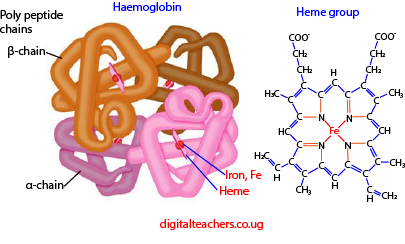
Structure and functions of hemoglobin

Structure of hemoglobin

Structure of hemoglobin
- Hemoglobin comprises four subunits, each having one polypeptide chain and one heme group.
- The polypeptide chains of adult hemoglobin are of two kinds, similar in length but differing in amino acid sequence.
- The two alpha chains each has 141 amino acid residue while the two beta chains each has 146 amino acid residues
- Heme, which accounts for only 4 percent of the weight of the molecule, is composed of a ring-like organic compound known as a porphyrin to which iron in oxidation state II is attached.
- Oxygen binds reversibly to the ferrous iron atom in each heme group.
- The binding of oxygen to the heme group of one subunit has an effect of increasing the affinity of a neighboring subunit (on the same molecule) for oxygen.
Functions of hemoglobin
- The main function of hemoglobin is to carry oxygen from the lungs to all the tissues of the body.
- Some of the carbon dioxide is transported from tissues to lungs through hemoglobin. Although the majority of it is transported via plasma still it carries some of CO2 to lungs.
- Buffering action:Hemoglobin also acts as a buffer. Buffer is a substance that resists change in pH. Blood has pH of 7.4 and it remains in the narrow range, because, if it changes, the life of the person may be endangered.
- Interaction with drugs: For not only oxygen but also hemoglobin act a very important role in the transport of various drugs to their site of action.
Please find free downloadable notes, exams and marking guides of agriculture, biology, Physics, chemistry etc. from digitalteachers.co.ug website. Dr. Bbosa Science
CATEGORIES General
TAGS Dr. Bbosa Science

Your blog is a source of inspiration for me. Clothes & Accessories